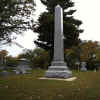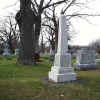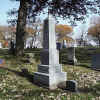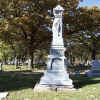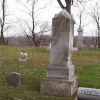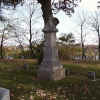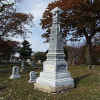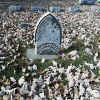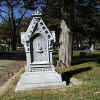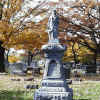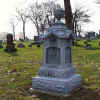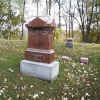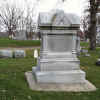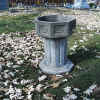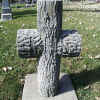Conclusion
The nineteenth century cemetery was a diverse place. Developing from European models,
the first American lawn and park cemeteries appeared in Brooklyn and Boston early in the
century. These cemeteries emphasized a "natural" look with winding pathways,
scrub, trees, and lakes. Architectural styling made the monuments in these cemeteries as
pleasing to the eye as the landscape. Nineteenth century Americans saw different types of
architecture appropriate for different uses. Egyptian architecture was seen as most
appropriate for cemeteries, Gothic for churches, and Classical for government buildings.
However, Greenwood Cemetery demonstrates that there was considerable cross over beyond
these generalizations. The nineteenth century was a time when independent craftsmen could
sculpt individualized monuments for a living, creating great diversity not only in
combining styles but within styles. Greenwood Cemetery reflects the period well. Its
landscape incredibly diverse, ranging from nineteenth century monuments placed
within the winding pathways of the Original Section to modern flat markers flanked by
straight lanes in the lawns beyond.
Endnotes
1. Carrot, Richard G, The Egyptian Revival (Berkley: University of California
Press, 1978), 2.
2. Carrot, 17.
3. Brown, John G, Soul in the Stone: Cemetery Art from America's
Heartland (Lawrence:
University of Kansas Press, 1994), 98.
4. Merner monument: Lot 88, 1st Add.
5. Winslow monument: 1885, Original Section, Block B, lot 217.
Mullarky monument: 1874, First Addition, lot 71.
6. Philpot monument: 1877, Original Section, Block G.
McKee monument: 1901, Original Section, Block A.
Larson monument: 1870, Original Section, Block G.
Chapman monument: 1860, Original Section, Block C.
7. Elias Overman: 1854, Original Section, Block C.
8. Charles Pulker: 1864, Original Section, Block C.
9. Plummer monument: 1910, First Addition.
10. McNally monument: Second Addition, Block 4, Lot 11.
11. Dr. J.W. Young: 1927, Original Section, Block G.
12. Sylvester Packard: 1888, Original Section, Block F.
13. Baptismal Fountain: Original Section, Block G.
14. Thomas Pryor: No Date, Original Section, Block K.
15. Willsher, Betty, Understanding Scottish Graveyards (Edinburgh: Canongate
Books, 1995),
23.
16. Brown, 71.
Bibliography
Brown, John G. Soul in the Stone: Cemetery Art from America's
Heartland.
Lawrence:
University of Kansas
Press, 1994.
Carrott, Richard G. The Egyptian Revival. Berkley: University of California
Press, 1978.
Gillon, Edmund V. Jr. Victorian Cemetery Art. New York: Dover Publications,
1972.
Northeast Iowa Genealogical Society. Greenwood Cemetery Index. Des Moines:
Iowa Genealogical Society,
1993.
Parker, John H. An Introduction to the Study of Gothic Architecture. London:
Simpkin,
Marshall & Co., 1925.
Willsher, Betty. Understanding Scottish Graveyards. Edinburgh: Canongate Books,
1995.
|
